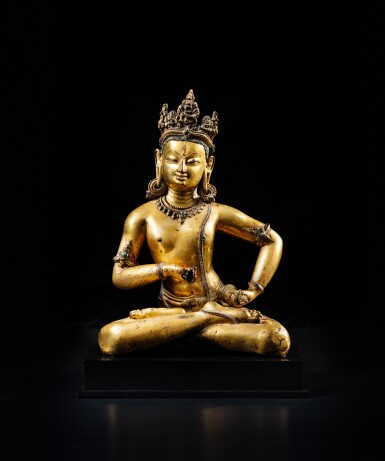Arts d'Asie
Arts d'Asie

PROPERTY FROM AN IMPORTANT EUROPEAN COLLECTION | 歐洲重要私人收藏
A rare gilt-copper figure of Vajrasattva, Nepal or Tibet, Khasa Malla Kingdom, 13th - 14th century | 十三至十四世紀 尼泊爾或藏西 卡薩馬拉王朝 鎏金銅金剛薩埵坐像
Auction Closed
June 14, 03:20 PM GMT
Estimate
300,000 - 400,000 EUR
Lot Details
Description
Property from an Important European Collection
A rare gilt-copper figure of Vajrasattva
Nepal or Tibet, Khasa Malla Kingdom, 13th - 14th century
Height 29 cm, 11⅜ in.
__________________________________________________________________________
Collection particulière européenne
Rare statuette de Vajrasattva en cuivre doré, Népal ou Tibet, Royaume de Khasa Malla, XIIIe - XIVe siècle
__________________________________________________________________________
歐洲重要私人收藏
十三至十四世紀 尼泊爾或藏西 卡薩馬拉王朝 鎏金銅金剛薩埵坐像
Acquired in London in 1986.
__________________________________________________________________________
於1986年得自倫敦
The primordial Buddha Vajrasattva is identified by the bell (ghanta) held down by the thigh, the raised right hand poised to hold the diamond sceptre (vajra), now missing, and the diminutive effigies of the Celestial Buddhas, or Tathagatas, depicted on the crown panels. The muscular modelling, the full facial features and the jewelry type suggest the work of artists commissioned by Khasa Malla patrons: compare an early fourteenth century gilt copper Sadaksari Avalokiteshvara with a dedicatory inscription naming the donor as a Ya tse sovereign — Ya tse being the Tibetan name for the Khasa Malla — at Bonhams New York, 23 July 2020, lot 848. The Vajrasattva’s remarkably close sculptural similarities with this royal Khasa Malla commission include the jewelled belt clasp, anklets, bracelets and armbands, the double-stranded sacred cord (yajnopavita), the pendant necklace type, the hoop earrings with a pendant gem, and the full and rounded modelling. Compare also the thirteenth or fourteenth century gilt copper Khasa Malla Maitreya at Bonhams New York, 23 September 2020, lot 616. The seated posture with legs crossed in the adamantine meditation position (vajraparyankasana), the elegant sway of the body, and gentle tilt of the head, are comparable to another robustly modelled gilt copper Vajrasattva with a crown depicting effigies of Tathagatas, which may also be a Khasa Malla commission, in John C. Huntington and Dina Bangdel, The Circle of Bliss: Buddhist Meditational Art, Columbus, 2003, cat. 57. Vajrasattva is considered to be the origin of Buddhist tantric practice and the primordial deity in the mandala of the Celestial Buddhas. In Nepalese ritual, an adept may wear a crown with a vajra finial that represents the Buddha Vajrasattva, and that depicts the Celestial Buddhas as they appear on the crown of this statue. The significance of the Vajrasattva crown in Buddhist practice is elaborated in Huntington and Bangdel, ibid, cat. nos. 60-62.
The Khasa Mallas were influential in western Nepal and western Tibet from the twelfth to the middle of the fourteenth century and commissioned Buddhist sculpture in a locally developed style, as documented by Ian Alsop in his seminal treatise, “Metal Sculpture of the Khasa Mallas”, in Jane Casey Singer & Philip Denwood, Tibetan Art: Towards a Definition of Style, London, 1997, pp. 68-79. Alsop observed diverse sculptural influences in bronzes from the region, including eastern Indian Pala period (8th-12th c.) traditions and Newar art of the Kathmandu Valley. The predominant influence in this sculpture of Vajrasattva is evident in the sensuous modelling associated with Newar artists, and their preferred medium of gilded copper. The necklace type however, with jewelled pendants and a minimum of inset gems, is rarely encountered in Kathmandu bronzes, but is common in eastern Indian works. In thirteenth and fourteenth century gilt bronzes from the Kathmandu Valley, the necklace and other items of jewelry such as the belt clasp would almost invariably be inset with a mixed multi-colored sequence of ruby-red, emerald-green, lapis-blue and turquoise-blue gems, crystals or paste. The design of Vajrasattva’s two necklaces, a simple beaded string of pearls above, and a string of pendant jewels below with a single stone setting in the central cluster, is often encountered in later Pala works such as the Avalokiteshvara in the Los Angeles County Museum of Art, see Pratapaditya Pal, Indian Sculpture, Los Angeles, 1988, Vol. II, cat. no. 85. Idiosyncratic stylistic elements thus place the statue apart from well-known Newar centres of bronze casting such as the Kathmandu Valley in eastern Nepal and Densatil Monastery in central Tibet, and firmly link the Vajrasattva to the artistic milieu of the Khasa Malla kingdom.
__________________________________________________________________________
此尊原始佛金剛薩埵,左手持鈴置於盤腿,右手握金剛杵,杵今已失,肌肉飽滿,面容豐滿,冠飾小像為諸天佛或如來,裝飾精美,應為卡薩瑪拉權貴委託工匠所製。可相較一尊十四世紀早期的銅鎏金四臂觀音像,其銘刻捐贈者為「雅則」君主,雅則為卡薩馬拉之藏文,該觀音像售於紐約邦瀚斯2020年7月23日,拍品編號848。本尊金剛薩埵造像風格及特徵與上述由卡薩馬拉皇室訂製之觀音極為相似,包括嵌寶腰帶扣、腳鏈、手鐲和臂鐲、聖線(yajnopavita)、垂飾式項鍊、鑲寶圓耳環,造型豐滿圓潤。另可參考一尊十三或十四世紀的卡薩馬拉銅鎏金彌勒菩薩像,售於在紐約邦瀚斯2020年9月23日,拍品編號616。本尊金剛薩埵雙腿交叉打金剛坐(vajraparyankasana),身體優雅地擺動,頭部輕微傾斜,與另一尊佩戴諸佛像皇冠之鎏金銅金剛薩埵相似,見約翰·C·亨廷頓和迪娜·邦德爾合著之《圓滿之環:佛教禪修藝術》,哥倫布,2003年,編號57。金剛薩埵被視為佛教密宗修行之起源,亦為諸天佛曼陀羅中的原始佛本尊。在尼泊爾的儀式中,修行者時而戴頂飾金剛杵頭冠,此冠冕象徵金剛薩埵佛。關於金剛薩埵冠冕在佛教實踐中的意義,可同樣參考上述書籍,編號60-62。
卡薩馬拉王朝在十二世紀至十四世紀中期對西尼泊爾和藏西地區影響深遠,並委託訂製大量當地風格的佛教造像。伊恩·艾爾索普在其重要論文《卡薩馬拉金屬造像》中有詳細記載,載於簡·凱西·辛格與菲利普·登伍德合編之《藏族藝術:風格定義之探討》,倫敦,1997年,頁68至79。艾爾索普觀察到該地區之銅雕造像受東印度帕拉時期(八至十二世紀)和加德滿都谷地紐瓦爾藝術等多重影響。本尊金剛薩埵,造型感性,並以鎏金銅鑄造,可見紐瓦爾藝術家之影響。此類項鍊帶有寶石墜飾,於加德滿都銅像中並不常見,然而於東印度甚為普遍。十三與十四世紀加德滿都谷地之鎏金銅造像,其項鍊等飾物如腰帶扣,常鑲嵌紅寶石、祖母綠、青金石及綠松石等多色寶石,亦有水晶或仿石。本尊金剛薩埵胸前上有簡約珠串,下有單顆寶石墜飾寶石串,此類雙鏈設計常見於帕拉後期,如洛杉磯縣藝術博物館所藏之觀音像,參見普拉塔帕蒂特亞·帕爾所著《印度雕塑》,洛杉磯,1988年,第二卷,編號85。本尊佛像風格元素獨特,與眾不同,與德滿都谷地東部及西藏中部之丹薩替寺等著名紐瓦爾造像有所區別。本尊金剛薩埵為卡薩馬拉藝術風格之典範。
